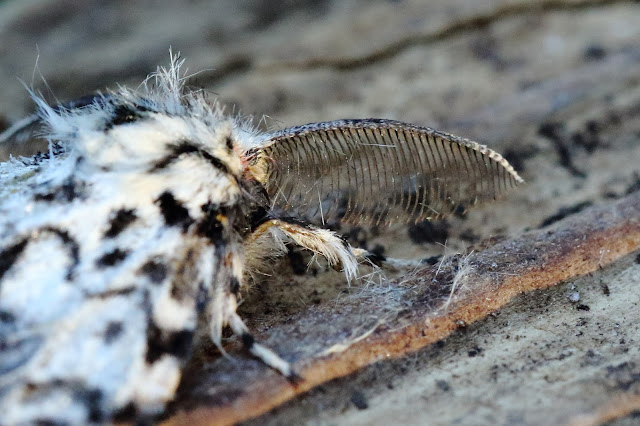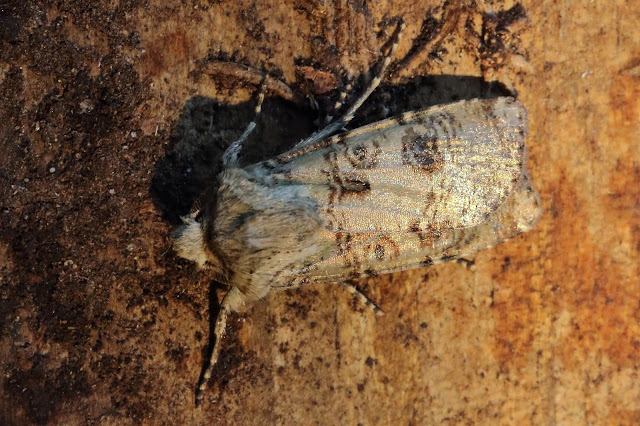A week or two ago, Andy M had a go at trapping moths in his back garden. Using a mercury light trap (kindly lent to him by David F), Andy set up the trap around 10pm on two warm, calm evenings, (on 6th and 11th July), placing the trap in the middle of a white sheet on the lawn near the woodland edge, and left it to work its magic overnight. The white sheet allows those moths that are attracted to the light, but do not find their way into the trap, to be more easily seen. Early the next morning, Andy carefully looked inside the trap, where a good number of moths come to rest in shadowy crannies under old egg cartons, and photographed as many as he could, for identification later. Andy started by photographing the moths on the egg cartons
in situ (just in case they decided to fly away), before moving them gently onto a leaf or piece of bark, where he photographed them again on a more natural background.
Moth trap on a white sheet, showing the egg cartons taken out of the trap the next morning, and a few boxes to temporarily hold the moths before photographing and releasing them.
Most of the rather splendid hawkmoths are relatively easy to identify, as are quite a few of the medium-sized moths. However, Andy also trapped a good number of very similar-looking smaller moths and micro-moths, that have thus far evaded identification! Please do let Andy know if you know what any of these 'unknown' moths are.
Andy found the following websites useful in identifying moths - although there are a surprisingly large number of moth species in the UK!
https://ukmoths.org.uk/.
https://butterfly-conservation.org/moths
Elephant Hawkmoth
Elephant Hawkmoth
Small Elephant Hawkmoth (separate species)
Small Elephant Hawkmoth and Elephant Hawkmoth species
Dark Arches
Dark Arches
Pine Hawkmoth
Pine Hawkmoth

Pine Hawkmoth - different day - different moth?
Pine Hawkmoth
Peppered Moth - dark variant
Peppered Moth - mid variant
Peppered Moth - pale variant
Peppered Moth - variants
Poplar Hawkmoth
Poplar Hawkmoth
Poplar Hawkmoth
Poplar Hawkmoth - showing red underwing flash
Lesser Broad-bordered Yellow Underwing
Broad-bordered Yellow Underwing
Broad-bordered Yellow Underwing
Scalloped Oak
Brown-line Bright-eye
Brown-line Bright-eye
Brown-line Bright-eye - fabulous antennae!
Brown-line Bright-eye and Box Tree Moth
Black Arches
Black Arches
Black Arches antennae
Swallow-tailed Moth
Common Footman
Common Footman
A 'Plume' moth Merrifieldia baliodactylus
Common Wainscot
Common Wainscot
Brown-tail
Brown-tail - 'playing dead' and showing its brown tail
Brown-tail
Short-cloaked Moth
Riband Wave - variant with black band
Riband Wave - variant with outlines only of banding
Clancy's Rustic
Clancy's Rustic
Common Rustic
Heart and Dart
Brimstone Moth - a rather tired specimen
Garden Carpet - also past its best
Twin-spotted Carpet
Even moths get ticks!!
Unidentified Moths- please let Andy M know if you have knowledge of what these might be.
'the one that got away ... into the lawn. Unidentified - possibly a Wainscot spp?
Unidentified - possibly a carpet species
 |
| Unidentified species - possibly a Wainscot spp |
































































No comments:
Post a Comment